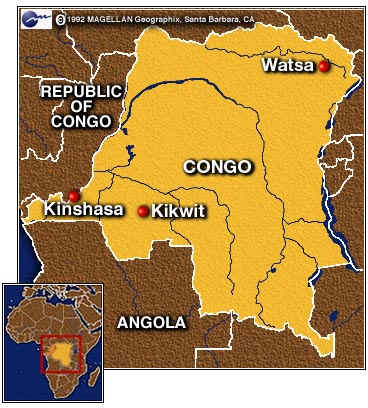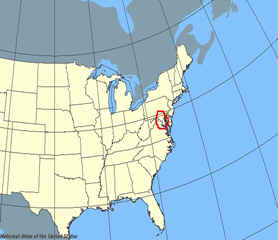
Recent Ebola Outbreaks

OUTBREAKS IN AFRICA:
Linking human outbreaks to ape outbreaks—Ebola outbreaks seem to occur in regions in or around the Congo. Multiple strains have emerged both within and between these outbreaks, suggesting that Ebola is endemic to this area. In fact, in the five most recent outbreaks (human and animal) in Gabon and the Congo, eight different strains were identified.
CNN, www.cnn.com/WORLD/africa/ 9905/03/congo.ebola/
Because Ebola has been shown to be highly stable over time and between patients within a single outbreak, researchers consider evidence of such a large number of strains within a short time period to suggest multiple animal reservoirs for the virus. While no reservoir has been identified yet, bats are strongly suspected as one source, as they appear to be able to host an Ebola infection (including shedding) without evidencing serious disease or death. Some of the other animals being researched as potential reservoirs are shrews and rats.
The rise in ape outbreaks is causing great concern among ecologists and conservationists, as species already endangered by hunting are dwindling further (Princeton University Ecologist Peter Walsh estimates that gorilla and chimpanzee populations have decreased by half over the past 20 years). However, because human outbreaks appear to originate with a single hunter coming into contact with an animal that has died of Ebola, medical workers are hoping to reduce both ape hunting and human infection by educating hunters on the dangers posed by the apes. Additionally, researchers hope that vaccines in development will work on apes as well as humans.
Between January and April 2003, an Ebola outbreak in the Congo Republic infected 143 people and claimed the lives of 128, showing an 89.5% mortality rate. The epidemic was centered in the regions of Mbomo and Kelle, and is suspected to have originated in the consumption of infected gorilla meat. The first case was reported on January 4, 2003.
Following rapidly on the tail of the last Ebola outbreak in the Congo Republic just six months earlier, the most recent outbreak has surfaced again in the town of Mbomo as well as Mbandza. This outbreak is suspected to have begun with hunters handling a dead boar that was infected with the virus. All died shortly thereafter, with the single exception of a boy who refrained from touching the animal.
Ebola outbreak in The Congo, November 2003 Disinfecting isolation wards
CNN, http://news.bbc.co.uk/2/hi/africa/3274609.stm www.regions.com.ua/ro/archive/ 2003/02/12/world.htm
References: WHO,"Ebola Hemorrhagic Fever," http://www.who.int/csr/don/archive/disease/ebola_haemorrhagic_fever/en/, WHO, "Ebola Hemorrhagic Fever in The Republic of Congo--Update 12," http://www.who.int/csr/don/2003_05_07/en/, WHO, "Ebola Hemorrhagic Fever in The Republic of Congo--Update 6,"http://www.who.int/csr/don/2004_01_06/en/, Science,"Ebola Outbreaks may have had Independent Sources," http://www.sciencemag.org/cgi/content/full/303/5656/298a, Nature, "Double Threat Decimates Apes," http://www.nature.com/nsu/030331/030331-15.html, CNN, "Ebola Suspected in Nine Deaths in Congo Republic," http://www.cnn.com/2003/WORLD/africa/11/07/ebola.outbreak.reut/, WHO/AFRO Press Release, "Ebola Cases in Congo Reach 115," http://www.afro.who.int/press/2003/pr20030310.html
POSSIBLE OUTBREAK AVERTED IN MARYLAND, U.S.:

On February 10, 2004, a postdoctoral scientist in Maryland, U.S., “grazed her hand” with a needle while working with a weakened form of the virus in infected mice. Within 24 hours, she was quarantined in a containment suite that hadn’t been used since 1985. Because the virus may have an incubation period of 2-21 days, she was to remain in the suite for “up to 30 days. As of this writing, there have been no reports of infection with the Ebola virus nor any signs or symptoms of hemorrhagic fever.
National Atlas, http://nationalatlas.gov/natlas/NatlasStart.asp
Reference: ProMed mail,"Ebola Virus, Laboratory Accident, U.S.A. (Maryland)," http://www.promedmail.org/pls/askus/f?p=2400:1001:113333538602381137::NO::F2400_P1001_BACK_PAGE,F2400_P1001_PUB_MAIL_ID:1008,24539
For more updates on Ebola outbreaks, see WHO "Ebola Hemorrhagic Fever," at http://www.who.int/csr/don/archive/disease/ebola_haemorrhagic_fever/en/
For a comprehensive epidemiological record of Ebola outbreaks, see CDC "Ebola Hemorrhagic Fever," at http://www.cdc.gov/ncidod/dvrd/spb/mnpages/dispages/ebotabl.htm